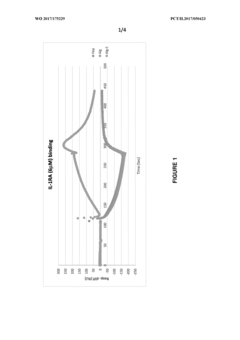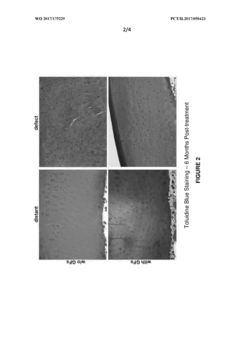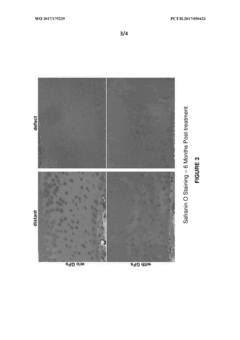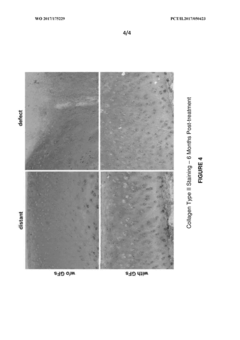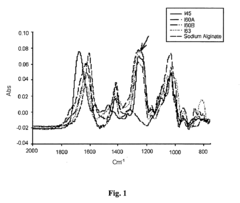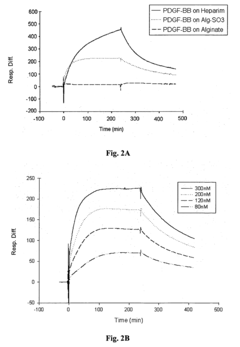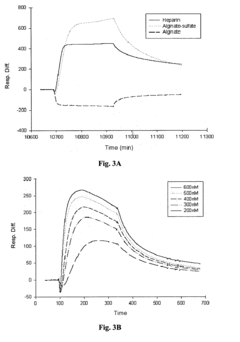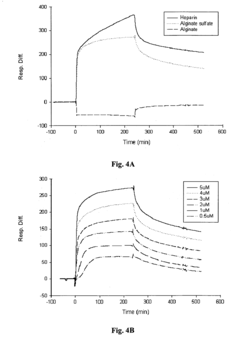How to Enhance Drug Delivery Using Sodium Alginate?
JUL 14, 20259 MIN READ
Generate Your Research Report Instantly with AI Agent
Patsnap Eureka helps you evaluate technical feasibility & market potential.
Sodium Alginate Drug Delivery Background and Objectives
Sodium alginate has emerged as a promising material for enhancing drug delivery systems due to its unique properties and versatility. This natural polysaccharide, derived from brown seaweed, has gained significant attention in the pharmaceutical industry over the past few decades. The primary objective of utilizing sodium alginate in drug delivery is to improve the efficacy, safety, and patient compliance of various therapeutic agents.
The development of sodium alginate-based drug delivery systems can be traced back to the 1980s when researchers first recognized its potential for controlled release formulations. Since then, the field has witnessed remarkable progress, with sodium alginate being employed in various forms, including hydrogels, microspheres, nanoparticles, and films. These diverse applications have opened up new possibilities for addressing challenges in drug delivery across multiple therapeutic areas.
One of the key drivers behind the growing interest in sodium alginate is its biocompatibility and biodegradability. These properties make it an ideal candidate for developing environmentally friendly and safe drug delivery systems. Additionally, sodium alginate's ability to form gels in the presence of divalent cations, such as calcium, has been extensively exploited to create responsive and targeted drug release mechanisms.
The evolution of sodium alginate-based drug delivery systems has been closely linked to advancements in polymer science and nanotechnology. Researchers have focused on modifying the structure and properties of sodium alginate to enhance its performance in drug delivery applications. This includes efforts to improve its mucoadhesive properties, increase its stability in physiological conditions, and fine-tune its drug release kinetics.
As the field progresses, the objectives of sodium alginate drug delivery research have expanded beyond simply achieving controlled release. Current goals include developing smart delivery systems that can respond to specific physiological stimuli, improving the bioavailability of poorly soluble drugs, and designing targeted delivery platforms for cancer therapeutics. There is also a growing emphasis on combining sodium alginate with other materials to create hybrid systems that leverage the strengths of multiple components.
Looking ahead, the future of sodium alginate in drug delivery appears promising, with ongoing research aimed at addressing existing limitations and exploring new applications. Key objectives include enhancing the mechanical properties of alginate-based materials, improving their stability in complex biological environments, and developing more sophisticated drug loading and release mechanisms. Additionally, there is a focus on scaling up production processes to facilitate the translation of laboratory findings into clinically viable products.
The development of sodium alginate-based drug delivery systems can be traced back to the 1980s when researchers first recognized its potential for controlled release formulations. Since then, the field has witnessed remarkable progress, with sodium alginate being employed in various forms, including hydrogels, microspheres, nanoparticles, and films. These diverse applications have opened up new possibilities for addressing challenges in drug delivery across multiple therapeutic areas.
One of the key drivers behind the growing interest in sodium alginate is its biocompatibility and biodegradability. These properties make it an ideal candidate for developing environmentally friendly and safe drug delivery systems. Additionally, sodium alginate's ability to form gels in the presence of divalent cations, such as calcium, has been extensively exploited to create responsive and targeted drug release mechanisms.
The evolution of sodium alginate-based drug delivery systems has been closely linked to advancements in polymer science and nanotechnology. Researchers have focused on modifying the structure and properties of sodium alginate to enhance its performance in drug delivery applications. This includes efforts to improve its mucoadhesive properties, increase its stability in physiological conditions, and fine-tune its drug release kinetics.
As the field progresses, the objectives of sodium alginate drug delivery research have expanded beyond simply achieving controlled release. Current goals include developing smart delivery systems that can respond to specific physiological stimuli, improving the bioavailability of poorly soluble drugs, and designing targeted delivery platforms for cancer therapeutics. There is also a growing emphasis on combining sodium alginate with other materials to create hybrid systems that leverage the strengths of multiple components.
Looking ahead, the future of sodium alginate in drug delivery appears promising, with ongoing research aimed at addressing existing limitations and exploring new applications. Key objectives include enhancing the mechanical properties of alginate-based materials, improving their stability in complex biological environments, and developing more sophisticated drug loading and release mechanisms. Additionally, there is a focus on scaling up production processes to facilitate the translation of laboratory findings into clinically viable products.
Market Analysis for Alginate-Based Drug Delivery Systems
The global market for alginate-based drug delivery systems has been experiencing significant growth in recent years, driven by the increasing demand for advanced drug delivery technologies and the unique properties of sodium alginate. This natural polymer, derived from brown seaweed, offers numerous advantages in drug delivery applications, including biocompatibility, biodegradability, and the ability to form hydrogels under mild conditions.
The pharmaceutical industry has shown a growing interest in alginate-based drug delivery systems due to their versatility and potential to improve drug efficacy while reducing side effects. These systems have found applications in various therapeutic areas, including cancer treatment, wound healing, and controlled release of both small molecule drugs and biologics.
Market research indicates that the alginate-based drug delivery market is expected to continue its upward trajectory, with a compound annual growth rate (CAGR) projected to be in the high single digits over the next five years. This growth is attributed to factors such as the rising prevalence of chronic diseases, increasing investment in research and development, and the growing adoption of targeted drug delivery approaches.
North America currently holds the largest market share in alginate-based drug delivery systems, followed by Europe and Asia-Pacific. The United States, in particular, is a key market due to its advanced healthcare infrastructure and high investment in pharmaceutical research. However, emerging economies in Asia-Pacific, such as China and India, are expected to witness the fastest growth rates in the coming years, driven by improving healthcare access and increasing focus on innovative drug delivery technologies.
Key market segments for alginate-based drug delivery systems include oral delivery, topical applications, and injectable formulations. Oral delivery represents the largest segment, owing to the ease of administration and patient compliance. However, injectable alginate-based systems are gaining traction, particularly in cancer therapy and tissue engineering applications.
The competitive landscape of the alginate-based drug delivery market is characterized by a mix of large pharmaceutical companies, specialty biotech firms, and academic research institutions. Collaborations between industry players and research organizations are becoming increasingly common, driving innovation and accelerating the development of novel alginate-based drug delivery platforms.
Despite the promising outlook, challenges remain in the widespread adoption of alginate-based drug delivery systems. These include regulatory hurdles, the need for standardization in alginate quality and characterization, and the requirement for large-scale manufacturing processes that maintain consistent product quality. Addressing these challenges will be crucial for realizing the full market potential of alginate-based drug delivery technologies.
The pharmaceutical industry has shown a growing interest in alginate-based drug delivery systems due to their versatility and potential to improve drug efficacy while reducing side effects. These systems have found applications in various therapeutic areas, including cancer treatment, wound healing, and controlled release of both small molecule drugs and biologics.
Market research indicates that the alginate-based drug delivery market is expected to continue its upward trajectory, with a compound annual growth rate (CAGR) projected to be in the high single digits over the next five years. This growth is attributed to factors such as the rising prevalence of chronic diseases, increasing investment in research and development, and the growing adoption of targeted drug delivery approaches.
North America currently holds the largest market share in alginate-based drug delivery systems, followed by Europe and Asia-Pacific. The United States, in particular, is a key market due to its advanced healthcare infrastructure and high investment in pharmaceutical research. However, emerging economies in Asia-Pacific, such as China and India, are expected to witness the fastest growth rates in the coming years, driven by improving healthcare access and increasing focus on innovative drug delivery technologies.
Key market segments for alginate-based drug delivery systems include oral delivery, topical applications, and injectable formulations. Oral delivery represents the largest segment, owing to the ease of administration and patient compliance. However, injectable alginate-based systems are gaining traction, particularly in cancer therapy and tissue engineering applications.
The competitive landscape of the alginate-based drug delivery market is characterized by a mix of large pharmaceutical companies, specialty biotech firms, and academic research institutions. Collaborations between industry players and research organizations are becoming increasingly common, driving innovation and accelerating the development of novel alginate-based drug delivery platforms.
Despite the promising outlook, challenges remain in the widespread adoption of alginate-based drug delivery systems. These include regulatory hurdles, the need for standardization in alginate quality and characterization, and the requirement for large-scale manufacturing processes that maintain consistent product quality. Addressing these challenges will be crucial for realizing the full market potential of alginate-based drug delivery technologies.
Current Challenges in Sodium Alginate Drug Delivery
Despite the promising potential of sodium alginate in drug delivery systems, several challenges persist in its application. One of the primary issues is the inconsistent gelation process, which can lead to variability in drug release profiles. The cross-linking of alginate with divalent cations, such as calcium, is sensitive to environmental factors, making it difficult to achieve reproducible and controlled drug release kinetics across different batches.
Another significant challenge is the rapid dissolution of alginate matrices in physiological conditions, particularly in the gastrointestinal tract. This can result in premature drug release, limiting the effectiveness of sustained-release formulations. The high hydrophilicity of alginate also poses problems in encapsulating hydrophobic drugs, which constitute a large portion of pharmaceutical compounds.
The mechanical stability of alginate-based drug delivery systems is another area of concern. Under physiological stress, such as in the digestive system, alginate gels may degrade or erode prematurely, compromising their ability to protect and deliver drugs to targeted sites. This is particularly problematic for oral drug delivery applications.
Furthermore, the bioavailability of drugs encapsulated in alginate matrices can be suboptimal. The large molecular size and negative charge of alginate can hinder its permeation across biological membranes, potentially reducing the absorption of encapsulated drugs. This limitation is especially pronounced for macromolecular drugs like proteins and peptides.
The scalability of alginate-based drug delivery systems also presents challenges. While laboratory-scale production may yield promising results, translating these formulations to industrial-scale manufacturing often encounters issues related to process control, uniformity, and cost-effectiveness. The variability in alginate sources and grades further complicates large-scale production and standardization efforts.
Lastly, the regulatory landscape for alginate-based drug delivery systems remains complex. As a naturally derived polymer, batch-to-batch variations in alginate composition can raise concerns about product consistency and safety. Regulatory agencies often require extensive characterization and quality control measures, which can prolong the development timeline and increase costs for bringing alginate-based drug delivery products to market.
Another significant challenge is the rapid dissolution of alginate matrices in physiological conditions, particularly in the gastrointestinal tract. This can result in premature drug release, limiting the effectiveness of sustained-release formulations. The high hydrophilicity of alginate also poses problems in encapsulating hydrophobic drugs, which constitute a large portion of pharmaceutical compounds.
The mechanical stability of alginate-based drug delivery systems is another area of concern. Under physiological stress, such as in the digestive system, alginate gels may degrade or erode prematurely, compromising their ability to protect and deliver drugs to targeted sites. This is particularly problematic for oral drug delivery applications.
Furthermore, the bioavailability of drugs encapsulated in alginate matrices can be suboptimal. The large molecular size and negative charge of alginate can hinder its permeation across biological membranes, potentially reducing the absorption of encapsulated drugs. This limitation is especially pronounced for macromolecular drugs like proteins and peptides.
The scalability of alginate-based drug delivery systems also presents challenges. While laboratory-scale production may yield promising results, translating these formulations to industrial-scale manufacturing often encounters issues related to process control, uniformity, and cost-effectiveness. The variability in alginate sources and grades further complicates large-scale production and standardization efforts.
Lastly, the regulatory landscape for alginate-based drug delivery systems remains complex. As a naturally derived polymer, batch-to-batch variations in alginate composition can raise concerns about product consistency and safety. Regulatory agencies often require extensive characterization and quality control measures, which can prolong the development timeline and increase costs for bringing alginate-based drug delivery products to market.
Existing Sodium Alginate Drug Delivery Mechanisms
01 Sodium alginate-based drug delivery systems
Sodium alginate is widely used in drug delivery systems due to its biocompatibility and ability to form hydrogels. These systems can be designed to control drug release rates and improve bioavailability. Various formulations, including nanoparticles, microspheres, and beads, can be developed using sodium alginate as a carrier for different types of drugs.- Sodium alginate-based drug delivery systems: Sodium alginate is widely used in drug delivery systems due to its biocompatibility, biodegradability, and ability to form hydrogels. It can be used to encapsulate various drugs, providing controlled release and improved bioavailability. These systems can be designed for oral, topical, or injectable administration, offering versatility in drug delivery applications.
- Sodium alginate in combination with other polymers: Combining sodium alginate with other polymers can enhance the properties of drug delivery systems. These composite materials can offer improved mechanical strength, stability, and drug release profiles. Common polymers used in combination with sodium alginate include chitosan, pectin, and cellulose derivatives, allowing for tailored drug delivery characteristics.
- Nanoparticle-based sodium alginate drug carriers: Sodium alginate can be used to formulate nanoparticles for drug delivery. These nanoparticles can improve drug solubility, enhance cellular uptake, and provide targeted delivery. The small size of nanoparticles allows for better penetration into tissues and cells, potentially increasing therapeutic efficacy while reducing side effects.
- Sodium alginate hydrogels for sustained drug release: Hydrogels formed from sodium alginate can provide sustained drug release over extended periods. These hydrogels can be designed to respond to various stimuli such as pH, temperature, or enzymatic activity, allowing for site-specific drug release. The porous structure of hydrogels also enables high drug loading capacity and protection of sensitive therapeutic agents.
- Sodium alginate in mucosal drug delivery: Sodium alginate is particularly useful in mucosal drug delivery systems due to its mucoadhesive properties. It can adhere to mucosal surfaces, prolonging the contact time of drugs with the absorption site. This property is beneficial for oral, nasal, and ocular drug delivery, potentially improving drug absorption and bioavailability across mucosal barriers.
02 Combination with other polymers for enhanced drug delivery
Sodium alginate is often combined with other polymers to create composite drug delivery systems with improved properties. These combinations can enhance drug encapsulation efficiency, control release kinetics, and provide additional functionalities such as mucoadhesion or pH-responsiveness. Common polymers used in combination with sodium alginate include chitosan, pectin, and synthetic polymers.Expand Specific Solutions03 Targeted drug delivery using modified sodium alginate
Sodium alginate can be chemically modified or functionalized to achieve targeted drug delivery. These modifications can include the addition of specific ligands or functional groups that allow for site-specific drug release or enhanced cellular uptake. This approach is particularly useful for cancer therapy and other applications requiring precise drug delivery to specific tissues or organs.Expand Specific Solutions04 Sodium alginate in oral drug delivery
Sodium alginate is extensively used in oral drug delivery formulations due to its ability to form gels in acidic environments. This property is exploited to develop gastroretentive dosage forms, floating drug delivery systems, and controlled-release matrices for oral administration. These formulations can improve drug absorption and reduce dosing frequency for various therapeutic agents.Expand Specific Solutions05 Sodium alginate in transdermal and topical drug delivery
Sodium alginate is utilized in transdermal and topical drug delivery systems due to its film-forming and moisturizing properties. It can be formulated into patches, gels, and creams to enhance drug permeation through the skin and provide sustained release. These formulations are particularly useful for delivering drugs with poor oral bioavailability or those requiring localized action.Expand Specific Solutions
Key Players in Alginate Drug Delivery Research and Development
The drug delivery enhancement using sodium alginate is in a growth phase, with increasing market size and technological advancements. The global market for this technology is expanding due to its applications in pharmaceuticals and biomedical fields. While the technology is relatively mature, ongoing research by companies and institutions is driving innovation. Key players like The Regents of the University of Michigan, LTS LOHMANN Therapie-Systeme AG, and Abbott Cardiovascular Systems, Inc. are contributing to the field's development. Universities such as Soochow University, Temple University, and Wake Forest University are also actively researching this area, indicating a strong academic-industry collaboration. The competitive landscape is diverse, with both established pharmaceutical companies and emerging biotech firms exploring sodium alginate-based drug delivery systems.
The Regents of the University of Michigan
Technical Solution: The University of Michigan has pioneered a sodium alginate-based drug delivery system for oral administration. Their approach involves creating a multilayered alginate matrix that protects drugs from degradation in the stomach and allows for controlled release in the intestines[7]. The system utilizes pH-responsive properties of modified alginates to achieve site-specific drug release. Additionally, they have developed techniques to incorporate probiotics within the alginate matrix, creating a synergistic effect for treating gastrointestinal disorders[9]. Recent advancements include the use of 3D printing technology to fabricate complex alginate structures with precise drug release kinetics[11].
Strengths: Enhanced oral bioavailability, protection of sensitive drugs, potential for personalized medicine. Weaknesses: Scalability challenges, potential variability in individual patient responses.
Soochow University
Technical Solution: Soochow University has developed an innovative approach using sodium alginate for transdermal drug delivery. Their system involves creating nanofibrous mats of sodium alginate through electrospinning techniques. These mats are loaded with drugs and can be applied directly to the skin, providing sustained release over extended periods[8]. The university's research has also focused on incorporating stimuli-responsive elements into the alginate nanofibers, allowing for on-demand drug release triggered by external stimuli such as temperature or electrical signals[10]. Recent developments include the integration of microneedle technology with alginate-based formulations for enhanced skin penetration of large molecule drugs[12].
Strengths: Non-invasive delivery method, potential for long-acting formulations, versatile platform for various drugs. Weaknesses: Limited to drugs that can permeate skin, potential skin irritation with long-term use.
Innovative Approaches in Alginate-Based Drug Release
Polysaccharide compositions and uses thereof
PatentWO2017175229A1
Innovation
- A multi-compartment hydrogel or scaffold comprising alginate, sulfated alginate, or hyaluronan sulfate, where one compartment is affinity-bound to bioactive polypeptides like IL-1RA, and another compartment lacks polypeptides, utilizing calcium phosphate for cross-linking and incorporating additives like hydroxyapatite or platelet-rich plasma for sustained release and tissue repair.
Bioconjugates comprising sulfated polysaccharides and their uses
PatentActiveUS20070110814A1
Innovation
- The development of bioconjugates comprising sulfated polysaccharides like alginate sulfate and hyaluronan sulfate, which specifically bind with bioactive peptides, enabling controlled and sustained release through affinity interactions.
Regulatory Considerations for Alginate-Based Drug Delivery Systems
The regulatory landscape for alginate-based drug delivery systems is complex and multifaceted, requiring careful consideration throughout the development and approval process. Regulatory bodies, such as the U.S. Food and Drug Administration (FDA) and the European Medicines Agency (EMA), have established specific guidelines for the evaluation and approval of these novel drug delivery systems.
One of the primary regulatory considerations is the classification of alginate-based drug delivery systems. Depending on their intended use and mechanism of action, these systems may be categorized as drugs, medical devices, or combination products. This classification significantly impacts the regulatory pathway and requirements for approval.
Safety and efficacy are paramount concerns for regulatory agencies. Manufacturers must provide comprehensive data demonstrating the biocompatibility of sodium alginate and any other materials used in the delivery system. This includes evaluating potential toxicity, immunogenicity, and long-term effects on the body. Additionally, the stability and consistency of the alginate formulation must be thoroughly documented to ensure product quality and performance.
The manufacturing process for alginate-based drug delivery systems is subject to stringent regulatory oversight. Good Manufacturing Practices (GMP) must be adhered to, with detailed documentation of production methods, quality control measures, and batch-to-batch consistency. Regulatory bodies may conduct inspections of manufacturing facilities to ensure compliance with these standards.
Clinical trials for alginate-based drug delivery systems require careful design and execution to meet regulatory requirements. The trial protocols must address specific safety and efficacy endpoints relevant to the delivery system's unique properties. Regulatory agencies may require additional studies to evaluate the pharmacokinetics and pharmacodynamics of drugs delivered via alginate-based systems compared to conventional formulations.
Intellectual property considerations also play a role in the regulatory process. Manufacturers must navigate patent landscapes and ensure that their alginate-based delivery systems do not infringe on existing patents. This may involve conducting thorough patent searches and potentially negotiating licensing agreements.
As alginate-based drug delivery systems often incorporate nanotechnology, additional regulatory guidelines specific to nanomaterials may apply. These guidelines address the unique properties and potential risks associated with nanoscale materials, requiring specialized characterization and safety assessments.
Finally, post-market surveillance is a critical regulatory requirement for alginate-based drug delivery systems. Manufacturers must implement robust pharmacovigilance programs to monitor and report any adverse events or unexpected effects associated with these novel delivery systems. This ongoing surveillance helps ensure the long-term safety and efficacy of the products in real-world use.
One of the primary regulatory considerations is the classification of alginate-based drug delivery systems. Depending on their intended use and mechanism of action, these systems may be categorized as drugs, medical devices, or combination products. This classification significantly impacts the regulatory pathway and requirements for approval.
Safety and efficacy are paramount concerns for regulatory agencies. Manufacturers must provide comprehensive data demonstrating the biocompatibility of sodium alginate and any other materials used in the delivery system. This includes evaluating potential toxicity, immunogenicity, and long-term effects on the body. Additionally, the stability and consistency of the alginate formulation must be thoroughly documented to ensure product quality and performance.
The manufacturing process for alginate-based drug delivery systems is subject to stringent regulatory oversight. Good Manufacturing Practices (GMP) must be adhered to, with detailed documentation of production methods, quality control measures, and batch-to-batch consistency. Regulatory bodies may conduct inspections of manufacturing facilities to ensure compliance with these standards.
Clinical trials for alginate-based drug delivery systems require careful design and execution to meet regulatory requirements. The trial protocols must address specific safety and efficacy endpoints relevant to the delivery system's unique properties. Regulatory agencies may require additional studies to evaluate the pharmacokinetics and pharmacodynamics of drugs delivered via alginate-based systems compared to conventional formulations.
Intellectual property considerations also play a role in the regulatory process. Manufacturers must navigate patent landscapes and ensure that their alginate-based delivery systems do not infringe on existing patents. This may involve conducting thorough patent searches and potentially negotiating licensing agreements.
As alginate-based drug delivery systems often incorporate nanotechnology, additional regulatory guidelines specific to nanomaterials may apply. These guidelines address the unique properties and potential risks associated with nanoscale materials, requiring specialized characterization and safety assessments.
Finally, post-market surveillance is a critical regulatory requirement for alginate-based drug delivery systems. Manufacturers must implement robust pharmacovigilance programs to monitor and report any adverse events or unexpected effects associated with these novel delivery systems. This ongoing surveillance helps ensure the long-term safety and efficacy of the products in real-world use.
Biocompatibility and Safety Assessment of Alginate Formulations
The biocompatibility and safety assessment of alginate formulations is a critical aspect in enhancing drug delivery using sodium alginate. Alginate, derived from brown seaweed, has gained significant attention in the pharmaceutical industry due to its unique properties and potential applications in drug delivery systems.
Alginate-based formulations have demonstrated excellent biocompatibility in numerous studies. The natural origin of alginate contributes to its low toxicity and minimal immune response when introduced into biological systems. This characteristic makes it an attractive option for various drug delivery applications, including oral, topical, and injectable formulations.
In vitro studies have shown that alginate-based materials exhibit minimal cytotoxicity across a wide range of cell types. These studies typically involve exposing cultured cells to alginate formulations and assessing cell viability, proliferation, and morphology. The results consistently indicate that alginate does not significantly impair cellular functions or induce cell death at concentrations relevant to drug delivery applications.
In vivo safety assessments have further corroborated the biocompatibility of alginate formulations. Animal studies have demonstrated that alginate-based drug delivery systems are well-tolerated when administered through various routes. Histological examinations of tissues exposed to alginate formulations generally show minimal inflammatory responses or tissue damage, supporting their safety profile.
The biodegradability of alginate is another crucial factor contributing to its safety profile. Alginate can be broken down by naturally occurring enzymes in the body, ensuring that the material does not accumulate in tissues over time. This property is particularly advantageous for long-term drug delivery applications, as it minimizes the risk of adverse effects associated with prolonged material retention.
However, it is essential to note that the safety and biocompatibility of alginate formulations can be influenced by various factors, including the source and purity of the alginate, the presence of additives or crosslinking agents, and the specific drug being delivered. Therefore, comprehensive safety assessments must be conducted for each unique alginate-based drug delivery system.
Regulatory agencies, such as the FDA and EMA, have established guidelines for evaluating the safety of biomaterials used in drug delivery. These guidelines typically require a battery of tests, including in vitro cytotoxicity assays, genotoxicity studies, and in vivo biocompatibility assessments. Alginate formulations must meet these stringent requirements to be considered safe for clinical use.
In conclusion, the extensive body of research on alginate biocompatibility and safety supports its use in drug delivery applications. However, ongoing research continues to refine our understanding of alginate's interactions with biological systems, ensuring that future alginate-based drug delivery formulations maintain high safety standards while maximizing therapeutic efficacy.
Alginate-based formulations have demonstrated excellent biocompatibility in numerous studies. The natural origin of alginate contributes to its low toxicity and minimal immune response when introduced into biological systems. This characteristic makes it an attractive option for various drug delivery applications, including oral, topical, and injectable formulations.
In vitro studies have shown that alginate-based materials exhibit minimal cytotoxicity across a wide range of cell types. These studies typically involve exposing cultured cells to alginate formulations and assessing cell viability, proliferation, and morphology. The results consistently indicate that alginate does not significantly impair cellular functions or induce cell death at concentrations relevant to drug delivery applications.
In vivo safety assessments have further corroborated the biocompatibility of alginate formulations. Animal studies have demonstrated that alginate-based drug delivery systems are well-tolerated when administered through various routes. Histological examinations of tissues exposed to alginate formulations generally show minimal inflammatory responses or tissue damage, supporting their safety profile.
The biodegradability of alginate is another crucial factor contributing to its safety profile. Alginate can be broken down by naturally occurring enzymes in the body, ensuring that the material does not accumulate in tissues over time. This property is particularly advantageous for long-term drug delivery applications, as it minimizes the risk of adverse effects associated with prolonged material retention.
However, it is essential to note that the safety and biocompatibility of alginate formulations can be influenced by various factors, including the source and purity of the alginate, the presence of additives or crosslinking agents, and the specific drug being delivered. Therefore, comprehensive safety assessments must be conducted for each unique alginate-based drug delivery system.
Regulatory agencies, such as the FDA and EMA, have established guidelines for evaluating the safety of biomaterials used in drug delivery. These guidelines typically require a battery of tests, including in vitro cytotoxicity assays, genotoxicity studies, and in vivo biocompatibility assessments. Alginate formulations must meet these stringent requirements to be considered safe for clinical use.
In conclusion, the extensive body of research on alginate biocompatibility and safety supports its use in drug delivery applications. However, ongoing research continues to refine our understanding of alginate's interactions with biological systems, ensuring that future alginate-based drug delivery formulations maintain high safety standards while maximizing therapeutic efficacy.
Unlock deeper insights with Patsnap Eureka Quick Research — get a full tech report to explore trends and direct your research. Try now!
Generate Your Research Report Instantly with AI Agent
Supercharge your innovation with Patsnap Eureka AI Agent Platform!
